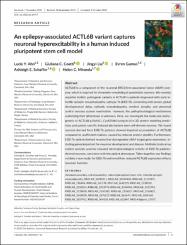An epilepsy-associated ACTL6B variant captures neuronal hyperexcitability in a human induced pluripotent stem cell model

Göster/
Tarih
2020;00:1–Yazar
Ahn, Lucie Y.Coatti, Giuliana C.
Liu, Jingyi
Gümüş, Evren
Schaffer, Ashleigh E.
Miranda, Helen C.
Üst veri
Tüm öğe kaydını gösterÖzet
ACTL6B is a component of the neuronal BRG1/brm-associated factor (nBAF) complex, which is required for chromatin remodeling in postmitotic neurons. We recently reported biallelic pathogenic variants in ACTL6B in patients diagnosed with early infantile epileptic encephalopathy, subtype 76 (EIEE-76), presenting with severe, global developmental delay, epileptic encephalopathy, cerebral atrophy, and abnormal central nervous system myelination. However, the pathophysiological mechanisms underlying their phenotype is unknown. Here, we investigate the molecular pathogenesis of ACTL6B p.(Val421_Cys425del) using in silico 3D protein modeling predictions and patient-specific induced pluripotent stem cell-derived neurons. We found neurons derived from EIEE-76 patients showed impaired accumulation of ACTL6B compared to unaffected relatives, caused by reduced protein stability. Furthermore, EIEE-76 patient-derived neurons had dysregulated nBAF target gene expression, including genes important for neuronal development and disease. Multielectrode array system analysis unveiled elevated electrophysiological activity of EIEE-76 patients-derived neurons, consistent with the patient phenotype. Taken together, our findings validate a new model for EIEE-76 and reveal how reduced ACTL6B expression affects neuronal function.

















